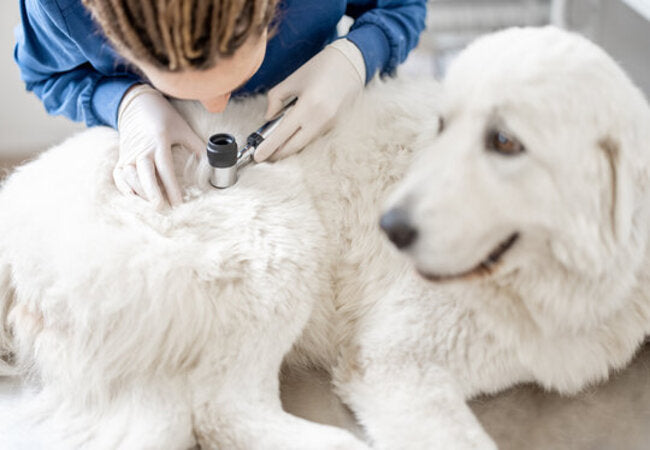Canine Skin Tags 2025: Vet-Approved Care & Removal Guide 🐕🩺

In this article
Vet’s 2025 Guide to Canine Skin Tags 🩺 Safe Care, Removal & Monitoring
By Dr. Duncan Houston BVSc
💡 What Are Skin Tags?
Skin tags—also known as acrochordons or fibrovascular papillomas—are small, benign, fleshy growths that often appear where skin rubs together, such as the armpits, groin, or neck. They consist of collagen, blood vessels, and connective tissue, and are more common in aging or friction-prone dogs. They typically match the dog’s skin color but may become slightly pigmented.
🚩 Who Gets Them & Why?
- 🏡 Often seen in older dogs; friction (collars, harnesses, skin folds) increases risk.
- 🐾 Breeds predisposed include Boxers, Bulldogs, Terriers, Hounds, and large breeds; any dog can develop them.
- 🧬 Papillomavirus may play a minor role, especially in clusters of growths.
- ⚠️ Rarely, growths mistaken for skin tags may be warts, cysts, lipomas, mast cell tumors, or other neoplasms.
👀 How to Recognize Skin Tags
- 🧵 Soft, flesh-colored, stalk-like bumps attached to the skin.
- 🚫 Not usually painful unless irritated by rubbing, chewing, or infection.
- 📍 Common on armpits, groin, neck, eyelids, belly, or pressure points.
- 🔍 They may stay the same size, slowly grow, or rarely regress.
- ❗ If they bleed, ulcerate, grow quickly, or change color, consult your vet.
🧪 Vet Diagnosis & Testing
- Physical exam: Veterinarians can often identify skin tags by appearance.
- Cytology: A Smear of cells helps rule out mast cell tumors or infections.
- Biopsy/histopathology: Gold standard if diagnosis is uncertain or growths are atypical—ensures it's not cancerous.
🛠 Treatment Options
1. No Treatment (Monitoring)
- Most skin tags are harmless and can be left alone if they don’t cause irritation.
2. Surgical Removal
- ✅ Excision or cauterization under local or general anesthesia is the only definitive cure.
- 🏥 Often done during routine procedures like spay/neuter; extra vet visits are scheduled if needed.
- 📆 Minor tags removed via cryotherapy or laser; healing is usually quick.
3. Cryotherapy or Laser Therapy
- ❄️ Freezing or precision laser removal minimizes scarring and is ideal for small tags (e.g., eyelid).
- 💸 Often used for cosmetic or difficult-to-access areas.
4. Antiviral or Immune Modulation (Rare Cases)
- 🦠 If tags are viral in origin, antiviral medications may help — but surgery remains the mainstay.
- 🧬 For cluster papillomavirus-related lesions, immune stimulation (imiquimod) or antibiotics like azithromycin may aid resolution.
📈 Prognosis & Follow-up
- ⭐ Prognosis is excellent—most dogs live normal lives after removal or with tags in place.
- 🔁 Monitor for recurrence or new growths; yearly skin exams are suggested.
- 🗓 Return and re-biopsy if lesions change suddenly in shape, size, or texture.
🚫 Home Care & Prevention
- 🛁 Regular grooming to reduce skin friction, especially in folds or pressure points.
- 👍 Use well-fitted collars/harnesses and soft bedding to avoid constant rubbing.
- ✔️ Clean and watch the area for signs of irritation, infection, redness, or bleeding.
🏡 Ask A Vet App Home‑Support Tools 📲🐶
- 📆 Schedule reminders for vet checks and grooming sessions.
- 📸 Upload clear photos of skin tags to share with your vet remotely.
- 📊 Log size, appearance changes, and any signs of irritation daily.
- 🔔 Alerts for sudden growth, bleeding, or discomfort prompting vet contact.
- 📚 Access guides on monitoring, biopsy prep, and post-removal care.
🔑 Key Takeaways 🧠✅
- Skin tags are typically benign fibrous growths that don’t need removal unless problematic.
- Veterinary evaluation rules out warts, cysts, tumors — including mast cell or basal cell tumors.
- Surgical excision or cryotherapy are safe, effective removal methods.
- Regular monitoring prevents surprises; home care reduces irritation risk.
- Ask A Vet app enables owner-led tracking and seamless communication with veterinary teams.
🩺 Final Thoughts ❤️
In 2025, skin tags in dogs are understood to be benign and often left untreated unless causing issues. With straightforward monitoring, gentle home care, and vet consultation for suspicious changes, owners can maintain their dog’s health and comfort. If removal is needed, simple procedures ensure minimal discomfort and quick recovery. Equipped with the Ask A Vet app, pup parents can track tags, send photos, and get timely veterinary input—bringing peace of mind with every wag 🐾✨.
Visit AskAVet.com and download the Ask A Vet app to track growths, schedule reminders, upload photos, and stay connected with veterinary guidance 24/7. 📲🐶






